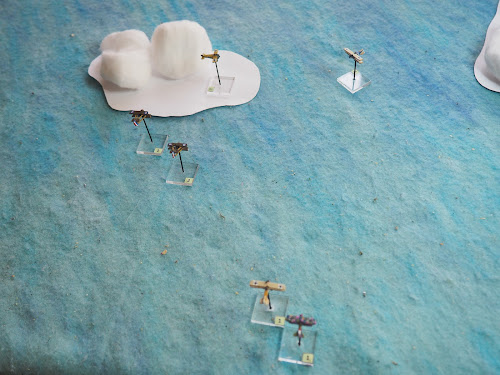In between making costume pieces for my latest burlesque act, and actual burlesque classes, I found time to fit in a quick game of 'Spandau and Lewis' this afternoon. Once again I ran through the random threat generation system, and used the planes from one of my earlier games - a couple of DH2s, against some German two-seaters and a mix of Halberstadt DIIs and Fokker EIIs.
I played on a larger area, and used 4D6 as the distance from the encounter. I also tried a tweak to the critical hits - any hit scores a critical on a second D6 roll of 6+, with a +1 to the roll for each 6 rolled in the hits.
Here's the DH2s - one ace in the lead and a novice tagging along.
The system generated a few opponents straight away a lone Fokker, a lone two-seater and a two-seater escorted by a Halberstadt.
The DH2s took cover in a cloud until they could pick some suitable targets without being spotted.
The lead DH2 sprung an ambush on the Fokker, but failed to score any hits.
This attracted the attention of the Halberstadt escort, who moved up to attack.
The DH2 pursued the Eindekker, but couldn't score a single hit on it. The Halberstadt was now closing up fast.
The Fokker took refuge in a cloud. The DH2 was now the prey ...
... and fell from the sky, its engine on fire.
This now left the novice DH2, which had started stalking a two-seater, the target of all of the scouts on the table. A second Fokker had joined the fray, ad quickly spotted the lone British plane. A second Halberstadt was also patrolling, but hadn't seen anything.
What's worse is that, by dint of good fortune for the Germans, one of the Fokkers, and the Halberstadt, were piloted by aces. The lone DH2 was in a lot of trouble. One Fokker pressed it close, whilst the Halberstadt moved in on an intercept course. The British pilot fled for home, but that board edge was still a long way away.
The British plane dodged and weaved, but was taking damage.
But somehow the Halberstadt pilot misjudged a turn and found himself with the DH2 on his tail. He escaped serious damage, and evaded, but it was a hairy moment. One of the Fokkers scored another hit on the DH2, but it kept flying.
But the British plane was running for home now. A single long-range shot from a Fokker failed to score any damage, and the DH2 escaped.














I love your clouds! I don;t think I ever seen clouds in an air wargame being represented by white cardboard and cotton wool. Very effective!
ReplyDeleteThanks. I'm a big fan of terrain being a flat piece of card or felt with removable objects on it, so this seemed the obvious approach
Delete